Talks by Erika Alden DeBenedictis
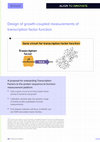
Design of growth-coupled measurements of transcription factor function Uses a gene circuit to tie... more Design of growth-coupled measurements of transcription factor function Uses a gene circuit to tie transcription factor activity to bacterial cell growth Calibration variants span the dynamic range of activity enable quantitative function measurements First dataset collection will focus on RamR, LacI and TetR transcription factor families. A proposal for onboarding Transcription Factors to the protein sequence-to-function measurement platform. Reviewed This document was created as a part of the Pooled, Growth-Based Assays for Protein Function Measurements pipeline 1 for Align to Innovate's Open Dataset Initiative. Align to Innovate is a non-profit research organization operating under open science principles with the goal of improving science research with programmable experiments. The Open Datasets Initiative is working to accelerate community-driven science with the use of automated labs to pioneer robust data collection methods and curated, high-fidelity, public biological datasets amenable to machine learning. This work was supported by Align to Innovate's Open Datasets Initiative which receives philanthropic funding in part from Griffin Catalyst.
Nature Biotechnology, 2024
This computational physicist and molecular biologist wants to solve big problems using evolution.... more This computational physicist and molecular biologist wants to solve big problems using evolution. Erika DeBenedictis began her scientific career as a computational physicist and astronomer, working on mission design and orbit planning at NASA's Jet Propulsion Laboratory. She is principal investigator at the Francis Crick Institute's Biodesign Laboratory and founder of Align to Innovate, a nonprofit that makes experimental life science more reproducible, scalable and sharable by giving researchers access to programmable experiments through programs like the Bioautomation Challenge.
Papers by Erika Alden DeBenedictis
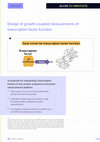
This article presents a proposal for measuring the function of transcription factors (TFs) using ... more This article presents a proposal for measuring the function of transcription factors (TFs) using a growth-coupled assay integrated with a gene circuit. This innovative approach links TF activity to bacterial cell growth, allowing for quantitative assessments of TF function across various families, starting with RamR, Lacl, and TetR. The methodology involves using plasmids designed for specific TFs, employing a range of calibration variants to span their activity dynamic range. The project aims to generate comprehensive datasets that will enhance understanding of TF repression mechanisms and the impact of mutations on their function, ultimately facilitating advancements in synthetic biology and therapeutic applications. The research is supported by a collaborative team from institutions such as NIST and Harvard Medical School, and it outlines a structured plan for both pilot and large-scale data collection efforts to expand the characterization of TFs across different families.

This article outlines a proposal for developing a high-throughput measurement platform for protea... more This article outlines a proposal for developing a high-throughput measurement platform for protease function using a gene circuit that links protease activity to bacterial cell growth. The system is designed to measure the activity of proteases, particularly focusing on the Tobacco Etch Virus (TEV) protease as an initial target. The circuit relies on the cleavage of lysozyme from a T7 RNA polymerase, which then enables gene expression and antibiotic resistance. The proposal details a two-stage approach for assay development, including tuning the system's dynamic range and establishing normalization and calibration controls. The project aims to collect data on thousands of protease sequence variants against multiple substrates, with potential applications in understanding protease specificity and developing therapeutic interventions. The authors also propose expanding the study to include structural homologs of TEV protease and non-canonical substrates, which could have implications for drug development and understanding protease evolution.
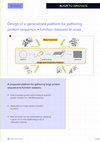
This article proposes a high-throughput experimental platform for collecting large-scale protein ... more This article proposes a high-throughput experimental platform for collecting large-scale protein function datasets. The platform utilizes a pooled, growth-based assay to measure protein function quantitatively, allowing for the analysis of up to 500,000 protein variants per experiment at a cost of approximately $0.05 per sequence. This method is designed to be adaptable to a wide variety of protein functions by validating gene circuits and establishing calibration variants. The process involves creating barcoded libraries of protein variants, transforming them into bacteria, growing them under selective conditions, and sequencing the barcodes to quantify differential growth rates. The data collected will populate an open dataset after an embargo period, facilitating the development of machine learning models to predict protein functions from DNA sequences. The platform aims to standardize data collection across different labs and protein families, ultimately contributing to the creation of a generalizable predictive model for protein function, which could significantly advance the field of biology.
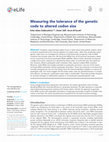
eLife, 2021
Translation using four-base codons occurs in both natural and synthetic systems. What constraints... more Translation using four-base codons occurs in both natural and synthetic systems. What constraints contributed to the universal adoption of a triplet codon, rather than quadruplet codon, genetic code? Here, we investigate the tolerance of the Escherichia coli genetic code to tRNA mutations that increase codon size. We found that tRNAs from all 20 canonical isoacceptor classes can be converted to functional quadruplet tRNAs (qtRNAs). Many of these selectively incorporate a single amino acid in response to a specified four-base codon, as confirmed with mass spectrometry. However, efficient quadruplet codon translation often requires multiple tRNA mutations. Moreover, while tRNAs were largely amenable to quadruplet conversion, only nine of the twenty aminoacyl tRNA synthetases tolerate quadruplet anticodons. These may constitute a functional and mutually orthogonal set, but one that sharply limits the chemical alphabet available to a nascent allquadruplet code. Our results suggest that the triplet codon code was selected because it is simpler and sufficient, not because a quadruplet codon code is unachievable. These data provide a blueprint for synthetic biologists to deliberately engineer an all-quadruplet expanded genetic code. Editor's evaluation Using a phage-based library generation and selection, the authors generated a suite of 4-base decoding tRNAs with improved efficiency in quadruplet decoding. The data represent an important step toward enhancing protein synthesis with 4-base codons. Overall, the approach to generate many tRNA variants with quadruplet anticodons is intriguing and provides a wealth of valuable information to the field. The results should become foundational for the field of synthetic biology.
PLOS Biology, 2023
Cloud labs, where experiments are executed remotely in robotic facilities, can improve the reprod... more Cloud labs, where experiments are executed remotely in robotic facilities, can improve the reproducibility, accessibility, and scalability of experimental biology. Funding and training programs will enable academics to overcome barriers to adopting such technology.
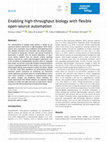
Molecular Systems Biology , 2021
Our understanding of complex living systems is limited by our capacity to perform experiments in ... more Our understanding of complex living systems is limited by our capacity to perform experiments in high throughput. While robotic systems have automated many traditional hand‐pipetting protocols, software limitations have precluded more advanced maneuvers required to manipulate, maintain, and monitor hundreds of experiments in parallel. Here, we present Pyhamilton, an open‐source Python platform that can execute complex pipetting patterns required for custom high‐throughput experiments such as the simulation of metapopulation dynamics. With an integrated plate reader, we maintain nearly 500 remotely monitored bacterial cultures in log‐phase growth for days without user intervention by taking regular density measurements to adjust the robotic method in real‐time. Using these capabilities, we systematically optimize bioreactor protein production by monitoring the fluorescent protein expression and growth rates of a hundred different continuous culture conditions in triplicate to comprehensively sample the carbon, nitrogen, and phosphorus fitness landscape. Our results demonstrate that flexible software can empower existing hardware to enable new types and scales of experiments, empowering areas from biomanufacturing to fundamental biology.
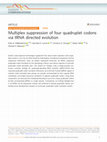
Nature Communications, 2021
Genetic code expansion technologies supplement the natural codon repertoire with assignable varia... more Genetic code expansion technologies supplement the natural codon repertoire with assignable variants in vivo, but are often limited by heterologous translational components and low suppression efficiencies. Here, we explore engineered Escherichia coli tRNAs supporting quadruplet codon translation by first developing a library-cross-library selection to nominate quadruplet codon-anticodon pairs. We extend our findings using a phage-assisted continuous evolution strategy for quadruplet-decoding tRNA evolution (qtRNA-PACE) that improved quadruplet codon translation efficiencies up to 80-fold. Evolved qtRNAs appear to maintain codon-anticodon base pairing, are typically aminoacylated by their cognate tRNA synthetases, and enable processive translation of adjacent quadruplet codons. Using these components, we showcase the multiplexed decoding of up to four unique quadruplet codons by their corresponding qtRNAs in a single reporter. Cumulatively, our findings highlight how E. coli tRNAs can be engineered, evolved, and combined to decode quadruplet codons, portending future developments towards an exclusively quadruplet codon translation system.
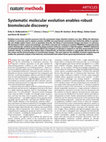
Nature Methods, 2022
Evolution occurs when selective pressures from the environment shape inherited variation over tim... more Evolution occurs when selective pressures from the environment shape inherited variation over time. Within the laboratory, evolution is commonly used to engineer proteins and RNA, but experimental constraints have limited the ability to reproducibly and reliably explore factors such as population diversity, the timing of environmental changes and chance on outcomes. We developed a robotic system termed phage- and robotics-assisted near-continuous evolution (PRANCE) to comprehensively explore biomolecular evolution by performing phage-assisted continuous evolution in high-throughput. PRANCE implements an automated feedback control system that adjusts the stringency of selection in response to real-time measurements of each molecular activity. In evolving three distinct types of biomolecule, we find that evolution is reproducibly altered by both random chance and the historical pattern of environmental changes. This work improves the reliability of protein engineering and enables the systematic analysis of the historical, environmental and random factors governing biomolecular evolution.
Protein Science, 2022
Sort-seq assays are a staple of the biological engineering toolkit, allowing researchers to profi... more Sort-seq assays are a staple of the biological engineering toolkit, allowing researchers to profile many groups of cells based on any characteristic that can be tied to fluorescence. However, current approaches, which segregate cells into bins deterministically based on their measured fluorescence, introduce systematic bias. We describe a surprising result: one can obtain unbiased estimates by incorporating randomness into sorting. We validate this approach in simulation and experimentally, and describe extensions for both estimating group level variances and for using multi-bin sorters.

Uploads
Talks by Erika Alden DeBenedictis
Papers by Erika Alden DeBenedictis